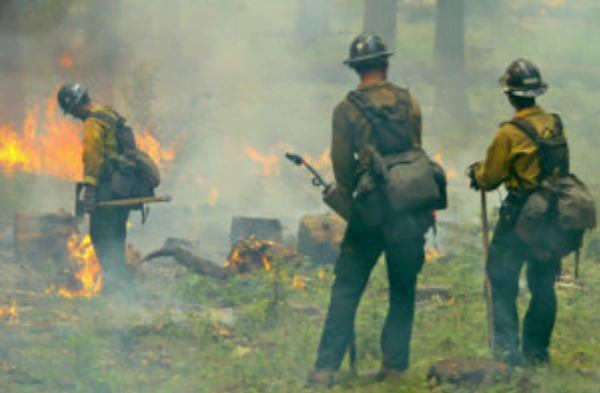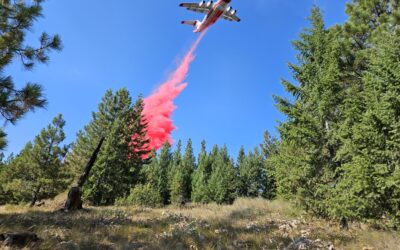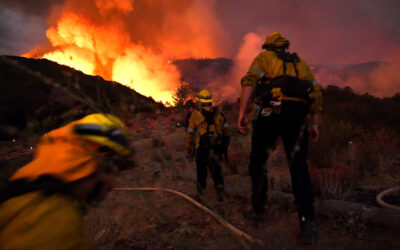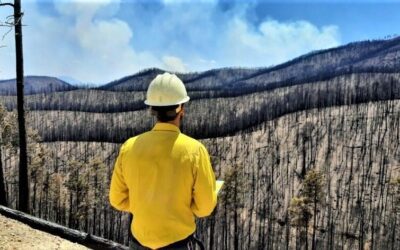Some of the items that I feel are necessary

By Chuck Sallade | FireRescue Magazine, Issue 8 Volume 7
Working as a firefighter in Montana allows you to experience various types of fires and firefighting techniques. My department is a structural department that, due to its location, also responds to wildland and wildland/urban interface (WUI) incidents.
Like most fire departments these days, we’re trained to be ready for anything; for us, that means training on and carrying a lot of equipment needed to fight WUI/wildland fires. So when deployed to these types of incidents, we bring along our line packs that, as many of you know, can be stuffed with anything from hand tools to bug spray. In this article, I’ll discuss some of the items that I feel are necessary to keep in your pack (and that I keep with me) at all times when deployed to a WUI/wildland fire.
Initial-Attack Ops Items
I actually have two line packs: one that I grab for initial-attack ops when assigned to the engine, and another, larger bag that I take with me when deployed to WUI/wildland incidents that are of longer duration and that take me away from the creature comforts of an engine.
The first bag, a Hotspot by Mystery Ranch, has only 550 cubic inches of space beyond the fire shelter pouch, because it’s intended for engine ops. I carry three fusees in the dedicated fusee pocket, as well as a small spanner wrench in the main compartment with a pair of fittings.
The fittings are adapters for 1″ NH to 1″ NPSH, and the two are zip-tied together. I carry these adapters, and many other departments do too, because if a progressive hoselay is out on the fireground from one type of hose, we can quickly adapt to it without having to search for the right fitting; we just grab the needed adapter from our bag, attach it and move on.
As simple as this may seem, we have, on occasion, run into this dilemma and been stumped, like when we were on mutual aid with the U.S. Forest Service years ago and learned the hard way that they use a different hose thread than we do. The zip-tied fittings are also stored in our engineer’s compartments, but keeping a pair in your pack is easy, and provides quick and cheap insurance against an easily avoidable frustration.
Attached to the waist strap of my pack is a Leatherman, because you never know what you might come across. Plus, a good multi-tool can usually get you out of almost any pinch within reason.
Lastly, I carry a nasty, stale granola bar from three years ago in the main compartment. We typically keep snacks in the compartments on the engines, but I have yet to find a time when I have really needed them. (You may want to carry fresher snacks than I do!)
Long-Duration Items
My second, larger pack is also made by Mystery Ranch. It’s called the HotTop, and it’s a burly bag that’s meant to take abuse on a daily basis. It features an internal rigid frame, which makes it the most comfortable pack I’ve worn to date, and a capacity of 1,700 cubic inches beyond the fire shelter pouch.
In the main compartment, I carry a beanie cap for cool nights, as well as an Icebreaker pullover, a pair of fresh socks, replacement shoelaces and spare gloves. In the Northern Rockies, it can get cool or even cold as soon as the sun goes down anytime after Labor Day. Also included are a Kestrel weather meter, a GPS, a headlamp, a map of our district, a Fireline Handbook and Appendix B, an MRE and a small Moleskin notepad that contains my identification, my current red card, and a picture of my lovely wife Kristin.
In the large outside compartment, I keep a department-issued first aid kit, but I added a few items that could be useful in a pinch if someone sustains a bleeding injury, such as a sanitary napkin because it’s sanitary, easy to use quickly and quite absorbent; a small tube of cyanoacrylate glue (or Crazy Glue); and latex gloves. Inside a zip-locked dry bag, I also keep AAA batteries for my gadgets, toilet paper and small roll of Gorilla tape for temporary fixes.
The pack also features two sizeable pouches, one on each side, that I use to store water bottles, a clam shell pack for my portable radio, my fusees, which are held in place by elastic straps within the pouch, the zip-tied fittings and a very dirty bandana.
On top of the top-load hole, there’s an auxiliary pouch connected to the main body of the bag that’s usually half full of ClifBloks, Oreo bites and peanut butter crackers, all of which are so pulverized by the time I get to them that it seems like I Gear-Tested a meat tenderizer on them. At that point, pouring them in all at once is so much easier than chewing them!
The belt on this pack holds my cheap, folding pocket knife with replaceable razor blades and a small pouch where I store a small spanner wrench and a Klein tool. For those of you who aren’t familiar with this tool, it’s kind of like channel locks but with nippers at the back. It grips, squeezes, twists, cuts, splices and dices (they should’ve called it a Ginsu). It can get you out of unusual situations, such as cutting a spool of barbed wire from your drive train in the middle of the night—I know, I’ve done it.
Lastly, I always wear a chest harness for easy access to my portable radio. The harness features a zippered pouch that holds a pen, the Incident Response Pocket Guide, another small Moleskin notepad and a cell phone.
Fit Your Needs
You might think all of this is a bit much—and I would agree at times—but a good rule to live by is to purchase a pack that fits your needs, kind of like buying a house. If your pack is bigger than you need, you’ll inevitably fill it with too much stuff, some necessary and some junk. A more modestly sized pack will probably keep you more honest with yourself, and thus make the bag less burdensome to carry.
That said, I’ve been on incidents with my smaller pack and wished I had grabbed the larger instead. Every spring I go through my line pack in preparation for fire season and inventory it (them). I look to see if there are items that I thought I’d find useful, but never did, and I make sure there are no important objects missing. The contents of my pack evolve year after year, with a focus on trying to keep the load as light as possible.




